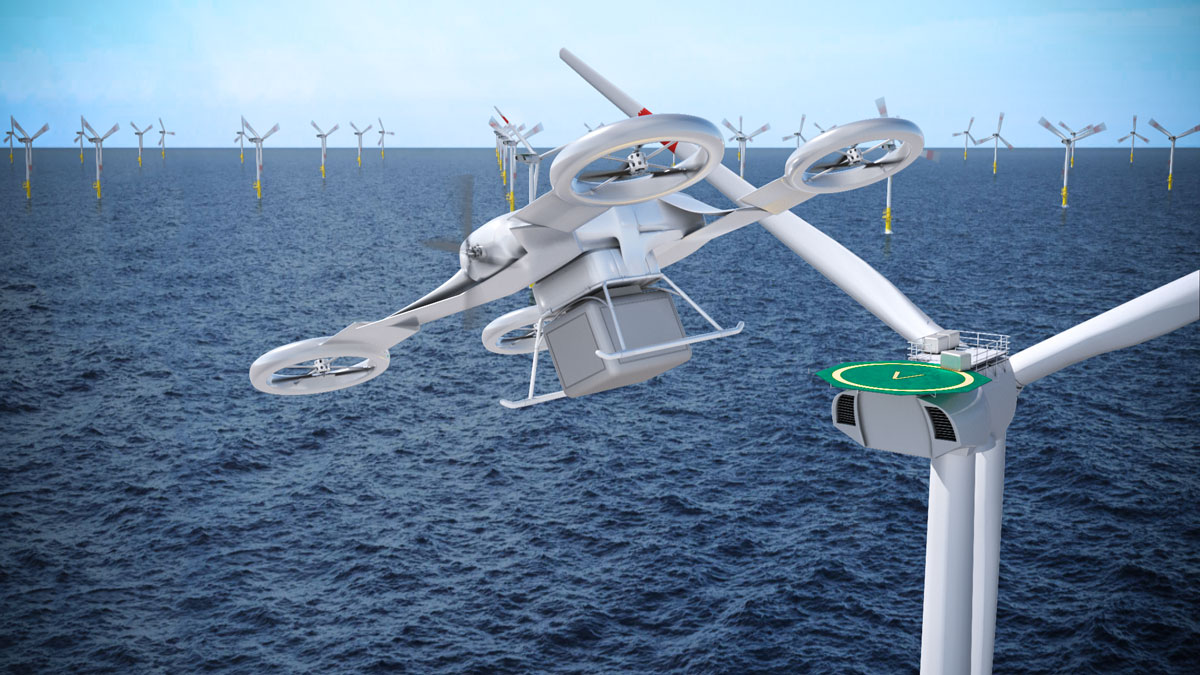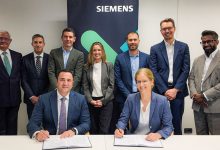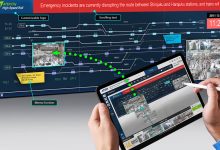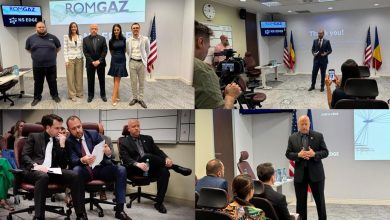EnBW and DLR Using Drones to Service Offshore Wind Farms
EnBW and the German Aerospace Center (DLR) join forces on a government funded research on the use of drones to service offshore wind farms. The project has been funded by the German Federal Ministry for Economic Affairs and Climate Protection and will explore the use of logistics and passenger drones to service offshore wind farms by flying people and materials out to sea.
Offshore wind energy is essential to the German Energiewende and sustainable energy supply, with offshore wind turbines making a major contribution to the security of the electricity supply. However, their location far from the coast also means long journeys for the maintenance teams, restricting a very valuable asset of every service technician: the effective time working on a wind turbine.
The engineer’s dream is to fly service technicians by air taxi to their assignment on a wind turbine, while their tools and materials are transported by cargo drone. In light of the many developments in urban air mobility aimed at expanding airborne transport systems, coupled with investments by logistics companies in drone technologies, it makes a lot of sense to look more closely at offshore wind farms as a potential application.
“We received only positive responses in our first discussions with drone experts. The use of drones can also add value and contribute to reduce costs. As flight paths are almost exclusively over uninhabited areas, we anticipate fewer restrictions than for Urban Air Mobility,” says Dr. Michael Splett, Head of Offshore Operations at EnBW.
Modern working practices are safe and well-rehearsed but time-consuming, and it is costly to accommodate service technicians at sea. Using cargo drones to transport tools and materials directly to the top of a 100-meter wind turbine would eliminate the need for cranes. If service technicians were to travel by air taxis, as passenger drones are called, there would be no need for transfers to the turbines and two-week shifts with overnight stays at sea.
“As the operator of offshore wind farms, we would like to contribute to making this new logistics approach a standard service worldwide,” says Michael Splett. “Our role is to bring wind energy and cargo drone technologies together and address a number of fundamental challenges. Among the issues to be clarified are how offshore wind farms need to be equipped to enable the use of drones, what a drone landing platform could look like, how a transport container needs to be designed and what communication interfaces could look like,” explains Jonas Janke, responsible project manager and offshore specialist at EnBW.
The research project funded by the German Federal Ministry for Economic Affairs and Climate Protection also aims to explore the legal framework for operating transport drones at offshore wind farms and identify any as yet uncovered legal aspects for this application or conflicts with existing regulations. The goal is to identify the conditions and necessary steps for implementing cargo and passenger drone transport operations.
DLR sets out the framework conditions for drone operation in the wind farm environment and makes its findings on unmanned aerial vehicles available. The scientists are conducting experiments with a DLR drone in a wind farm on land. In parallel, operation in the offshore area is being developed as a model and closely examined in simulations.
To ensure that the research project is not just an exercise in theory, extensive practical testing is already being prepared in the form of the Offshore Drone Challenge (ODC).
“We are inviting all technology players to benefit from our research results and demonstrate them live to the world’s trade press in tests with their own products,” says Jonas Janke. EnBW is already working on the competition design, together with DLR and other partners. A top-class jury will then award the “Drone Oscars”. The first ODC workshops will be held in fall at Hamburg Wind Energy 2022, the wind energy industry’s principal trade fair.
The research project
Drone technology will play an even larger role worldwide, particularly in the area of logistics. Many sectors see real potential for the transportation of people and materials. The EnBW research project will examine whether the use of drones is promising for the offshore wind sector and especially establish which requirements will need to be met.
Logistical challenges associated with ever larger offshore wind farms are expected to be met by automated transport drones in the future to reduce operating costs.
About EnBW
EnBW is one of the largest energy companies in Germany and Europe with around 26,000 employees. It supplies around 5.5 million customers with electricity, gas, water as well as services and products in the areas of infrastructure and energy. The installed output of renewable energies will reach 50 percent of the entire portfolio by the end of 2025. This is already having a noticeable effect on reducing CO2 emissions, which EnBW aims to halve by 2030. EnBW is aiming for climate neutrality by 2035.
EnBW R&D is systematically exploring innovative wind energy technologies. In the SkyPower100 project (FKZ 032417A-D), the company is collaborating with SkySails to examine aspects of the commercialization of airborne wind energy. In the Nezzy2 project, EnBW is collaborating with Aerodyn to explore the potential of a floating foundation with a self-aligning downwind double rotor. The Global Blockage Effect Baltic 2 project used scanning LIDAR to perform a measuring campaign and verify DNV’s wind field simulations in order to isolate the GBE from other influencing factors. The company is also involved in a large number of international Offshore Wind Accelerator (OWA) projects. EnBW is a major operator with various maintenance concepts that are subject to ongoing development. Offshore Operations is constantly examining innovations for incorporation into its work processes (e.g., VR in training, robotics in inspection).







